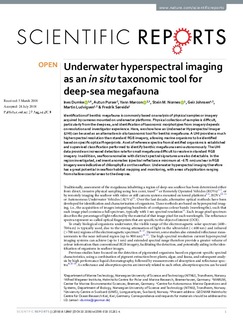| dc.contributor.author | Dumke, Ines | |
| dc.contributor.author | Purser, Autun | |
| dc.contributor.author | Marcon, Yann | |
| dc.contributor.author | Nornes, Stein Melvær | |
| dc.contributor.author | Johnsen, Geir | |
| dc.contributor.author | Ludvigsen, Martin | |
| dc.contributor.author | Søreide, Fredrik | |
| dc.date.accessioned | 2018-08-31T08:01:08Z | |
| dc.date.available | 2018-08-31T08:01:08Z | |
| dc.date.created | 2018-08-27T12:22:16Z | |
| dc.date.issued | 2018 | |
| dc.identifier.issn | 2045-2322 | |
| dc.identifier.uri | http://hdl.handle.net/11250/2560200 | |
| dc.description.abstract | Identification of benthic megafauna is commonly based on analysis of physical samples or imagery acquired by cameras mounted on underwater platforms. Physical collection of samples is difficult, particularly from the deep sea, and identification of taxonomic morphotypes from imagery depends on resolution and investigator experience. Here, we show how an Underwater Hyperspectral Imager (UHI) can be used as an alternative in situ taxonomic tool for benthic megafauna. A UHI provides a much higher spectral resolution than standard RGB imagery, allowing marine organisms to be identified based on specific optical fingerprints. A set of reference spectra from identified organisms is established and supervised classification performed to identify benthic megafauna semi-autonomously. The UHI data provide an increased detection rate for small megafauna difficult to resolve in standard RGB imagery. In addition, seafloor anomalies with distinct spectral signatures are also detectable. In the region investigated, sediment anomalies (spectral reflectance minimum at ~675 nm) unclear in RGB imagery were indicative of chlorophyll a on the seafloor. Underwater hyperspectral imaging therefore has a great potential in seafloor habitat mapping and monitoring, with areas of application ranging from shallow coastal areas to the deep sea. | nb_NO |
| dc.language.iso | eng | nb_NO |
| dc.publisher | Nature Publishing Group | nb_NO |
| dc.relation.uri | https://www.nature.com/articles/s41598-018-31261-4.pdf | |
| dc.rights | Navngivelse 4.0 Internasjonal | * |
| dc.rights.uri | http://creativecommons.org/licenses/by/4.0/deed.no | * |
| dc.subject | Marinbiologi | nb_NO |
| dc.subject | Marine biology | nb_NO |
| dc.title | Underwater hyperspectral imaging as an in situ taxonomic tool for deep-sea megafauna | nb_NO |
| dc.type | Journal article | nb_NO |
| dc.type | Peer reviewed | nb_NO |
| dc.description.version | publishedVersion | nb_NO |
| dc.subject.nsi | VDP::Marin teknologi: 580 | nb_NO |
| dc.subject.nsi | VDP::Marine technology: 580 | nb_NO |
| dc.source.volume | 8 | nb_NO |
| dc.source.journal | Scientific Reports | nb_NO |
| dc.identifier.doi | 10.1038/s41598-018-31261-4 | |
| dc.identifier.cristin | 1604641 | |
| dc.relation.project | EC/FP7/604500 | nb_NO |
| dc.relation.project | Norges forskningsråd: 250228 | nb_NO |
| dc.relation.project | Norges forskningsråd: 223254 | nb_NO |
| dc.description.localcode | © The Author(s) 2018. This article is licensed under a Creative Commons Attribution 4.0 International License. | nb_NO |
| cristin.unitcode | 194,64,20,0 | |
| cristin.unitcode | 194,66,10,0 | |
| cristin.unitname | Institutt for marin teknikk | |
| cristin.unitname | Institutt for biologi | |
| cristin.ispublished | true | |
| cristin.fulltext | original | |
| cristin.qualitycode | 1 | |

